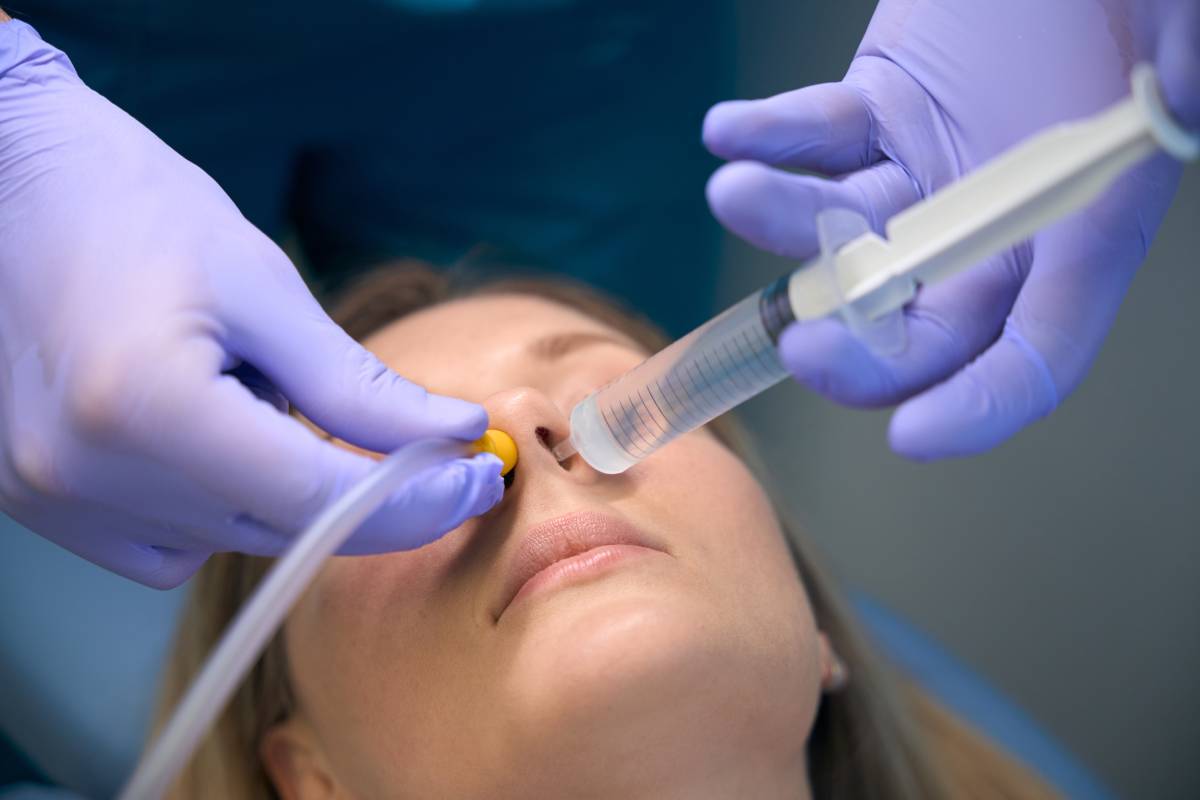Nasal Medication in Anesthesia

Nasal medication administration has emerged as a valuable approach in anesthesia, offering unique benefits that complement other methods. The nasal route leverages the rich vascularization and permeability of the nasal mucosa for rapid absorption and onset of action for certain drugs in a less invasive, potentially less stressful approach than more common routes. Nasal medication has uses in preoperative preparation, sedation, pain management, and emergency interventions, making it a significant innovation in modern anesthesia.
The nasal cavity is lined with a mucosal layer rich in blood vessels, providing a direct pathway for medications to enter systemic circulation without first passing through the gastrointestinal tract or liver. This bypass of first-pass metabolism enhances bioavailability, making nasal delivery particularly effective for drugs with otherwise low oral bioavailability. In addition, the proximity of the nasal cavity to the brain offers potential for direct delivery to the central nervous system, which is advantageous for certain anesthetics and sedatives 1.
Nasal medication in anesthesia can serve several purposes, including preoperative sedation and pain relief. Preoperative sedation is an important aspect of managing anxiety before surgery, with certain sedative medications such as midazolam being available in nasal forms. Nasal midazolam offers rapid sedation without the need for intravenous access, making it especially beneficial for pediatric patients or those with a fear of needles. For pain management, intranasal opioids can provide quick and effective relief, especially in cases where intravenous access is not immediately available.
In emergencies, rapid intervention is facilitated by intranasal medications such as naloxone, which can reverse opioid overdose, and intranasal dexmedetomidine, which helps manage agitation and facilitates non-invasive procedures. Furthermore, nasal medications also serve as adjuncts to general anesthesia, with lidocaine sprays anesthetizing the nasal mucosa to reduce discomfort during procedures like nasotracheal intubation 2–4. Finally, in pediatric applications, where children are often resistant to needles, the nasal route can help with administering sedatives or analgesics. For example, intranasal ketamine can provide sedation and pain control with minimal distress 5,6.
Nasal medication in anesthesia offers several advantages, including being non-invasive, which avoids the discomfort and complications associated with intravenous access. It also provides a rapid onset, delivering medications quickly into the systemic circulation for prompt therapeutic effects. The method is easy to use, requiring no specialized skills, making it useful for emergency or field settings. Additionally, nasal delivery may improve patient compliance—particularly for pediatric or anxious patients—since it is less intimidating than needles for some patients 7–9.
Despite its advantages, nasal medication has limitations. Variability in absorption due to nasal congestion or mucosal irritation can affect drug efficacy. Some patients may find nasal sprays uncomfortable or experience side effects like irritation or epistaxis. Additionally, the volume of medication that can be delivered nasally is limited, restricting its use for high-dose requirements 7–9.
References
1. Hussein, N. R., Omer, H. K., Elhissi, A. M. A. & Ahmed, W. Chapter 15 – Advances in nasal drug delivery systems. in Advances in Medical and Surgical Engineering (eds. Ahmed, W., Phoenix, D. A., Jackson, M. J. & Charalambous, C. P.) 279–311 (Academic Press, 2020). DOI: 10.1016/B978-0-12-819712-7.00015-2.
2. Kisku, A. et al. Recent developments in intranasal drug delivery of nanomedicines for the treatment of neuropsychiatric disorders. Front. Med. 11, (2024). DOI: 10.3389/fmed.2024.1463976
3. Kanazawa, T., Fukuda, M., Suzuki, N. & Suzuki, T. Novel Methods for Intranasal Administration Under Inhalation Anesthesia to Evaluate Nose-to-Brain Drug Delivery. J Vis Exp (2018) DOI: 10.3791/58485.
4. Dave, S., Shriyan, D. & Gujjar, P. Newer drug delivery systems in anesthesia. J Anaesthesiol Clin Pharmacol 33, 157–163 (2017). DOI: 10.4103/joacp.JOACP_63_16
5. Wolfe, T. R. & Braude, D. A. Intranasal medication delivery for children: a brief review and update. Pediatrics 126, 532–537 (2010). DOI: 10.1542/peds.2010-0616
6. Parida, S. & Senthilnathan, M. Administration of paediatric intranasal sedation: Need for appropriate formulation & equipment for dispensation. The Indian Journal of Medical Research 157, 96 (2023). DOI: 10.4103/ijmr.ijmr_847_22
7. Djupesland, P. G. Nasal drug delivery devices: characteristics and performance in a clinical perspective—a review. Drug Deliv. and Transl. Res. 3, 42–62 (2013). DOI: 10.1007/s13346-012-0108-9
8. Chung, S. et al. The nose has it: Opportunities and challenges for intranasal drug administration for neurologic conditions including seizure clusters. Epilepsy Behav Rep 21, 100581 (2022). DOI: 10.1016/j.ebr.2022.100581
9. Katare, P. et al. Nasal Drug Delivery System and Devices: An Overview on Health Effects. ACS Chem. Health Saf. 31, 127–143 (2024).
